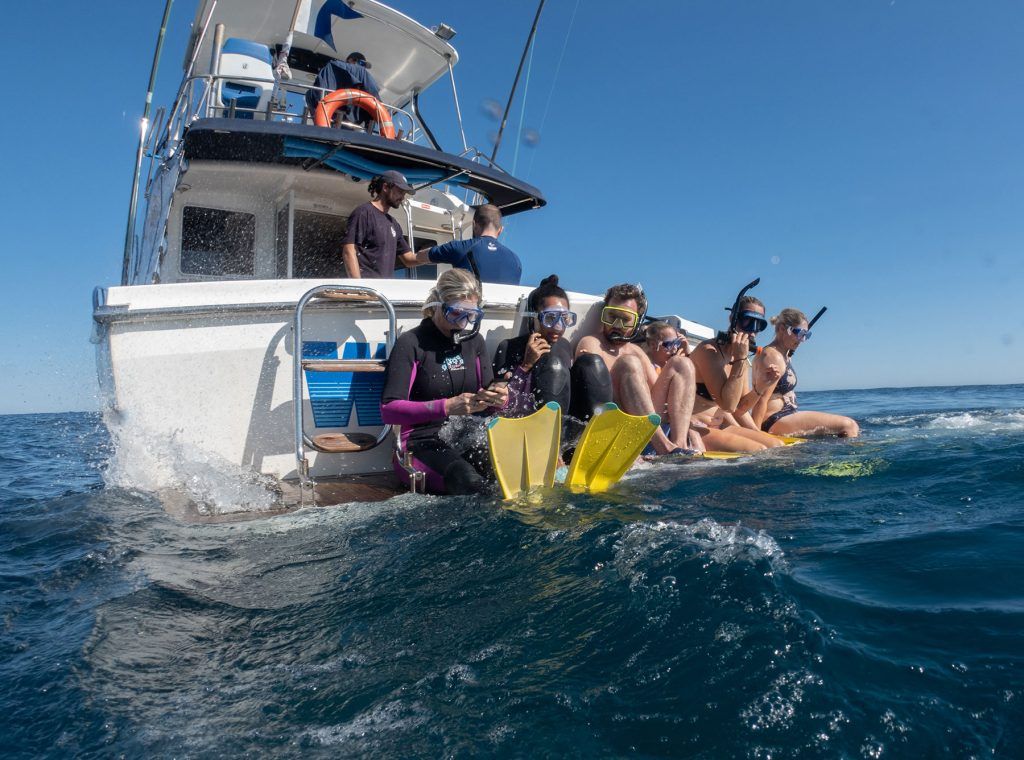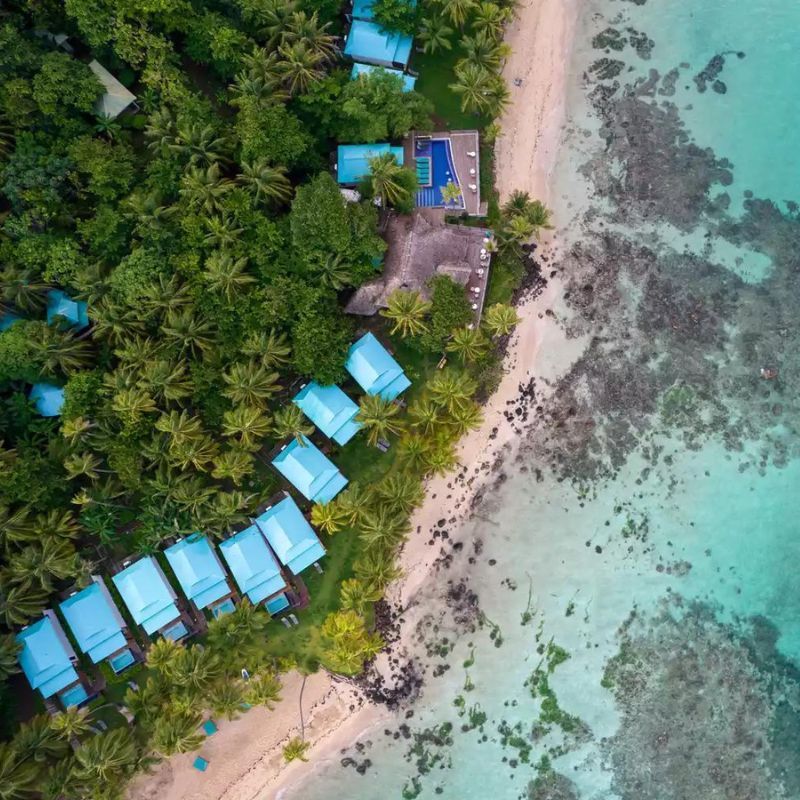
Off the wild, whale-filled coast of Western Australia, our marine biologist correspondent dips into the lives of some of the ocean’s mightiest inhabitants—twice!—and finds herself awestruck at every turn.

FORTY-FIVE KILOMETERS OFF the southern coast of Western Australia, the Southern Ocean has a bumpy texture that makes me grateful for seasickness tablets. Together with my family, I’d boarded this whale-watching boat in Bremer Bay, 500 kilometers southeast of Perth and now, the mainland is a distant smudge on the horizon.

Like a tiny bobbing cork, our vessel perches between 360 degrees of sky above and 1,000-meters of saltwater below. Imagining all the creatures that could be between me and that distant sea floor makes my head spin, and I’m awestruck by the scale of this environment.
Our skipper says we’ve arrived at the ‘hot spot,’ where eons ago, prehistoric rivers carved out the Bremer Canyon. Deep underwater vents release nutrients, and currents flush a rich cocktail of life upwards through the canyons.

All this food attracts an all-star line-up of marine creatures: giant squid, sperm whales, blue whales, beaked whales and oceanic sunfish. But on this tour, the mighty killer whale, or orca, is the headline act.
Onboard marine biologist Pia Markovic, says the four-kilometer-wide hot-spot in Western Australia hosts about 180 orcas from January to April each year, the largest known aggregation in the southern hemisphere. Puzzlingly, no one knows where they migrate to, and these individuals have not been sighted in other orca areas.
On the hunt

Thrillingly, a family pod of about seven orcas appear ahead of the boat. Females and juveniles surface and dive gently, and we scurry for our cameras.
The orcas epitomize grace; the kids even call them ‘cute.’ But within seconds, we’re being schooled by the ocean’s apex predators. Their numbers are growing, and orcas seem to be steaming in from all directions.
Beneath a swirl of albatrosses, storm petrels and shearwaters, the orcas are hunting. Experienced mother and grandmother orcas lead several pods in the hunt, their sickle shaped dorsal fins surging through the water.

The 10-meter-long males join the hunt. Weighing up to 4,000 kilograms, they drive walls of water before them. Mere meters from us, the ocean churns with black tails and white bellies, erupting with about 60 orcas.
“Right beside us – it’s a kill!” yells the skipper from the flybridge.
The life of a Gray’s beaked whale is over. Grotesque flesh-tearing begins, and birds brazenly steal morsels between orcas.
We’re shocked by the ferocity. Passengers and crew alike are yelling, gasping, and above all, awed. My heart is pounding, I’m covered in goosebumps, and I’m even a little shaky. We’ve just witnessed organized pack-hunting, surely one of nature’s most powerful moments.

I worry the bloodshed might upset the kids, but they understand the loss of one life makes others possible, and we see newborn orca calves learning to tear meat from the disappearing carcass.
Satiated for now, the orcas begin to play.
“There’s Split-fin,” Pia says. “She’s the boss of this pod.”
Standing on the bow of the boat, I gaze with admiration at Split-fin. Rolling over, she glides belly-up around the boat, and for a moment, she stares right back at me. Her curiosity is clear, and it gets me wondering. Would all whales be this inquisitive? What it would be like to join a whale in their world?
Ningaloo calls

Months later, I’m on a different West Australian boat, this time 1,300 kilometers north of Perth at Ningaloo Reef. Seated on the marlin board at the back of the boat in full snorkeling regalia, my pulse races. I’m awaiting the signal to slide in.
Between March and July each year, visitors flock to Ningaloo to swim with harmless whale sharks, the biggest fish in the sea. But there are other giants here too, and I’m here to try a newer wildlife experience – swimming with humpback whales.
During the cooler months in Australia, the west coast is treated to the breaches, pectoral slapping and cavorting of up to 40,000 humpback whales as they migrate from Antarctica to Australia’s tropical breeding grounds.
My visit occurs in August, and I’d joined the Life on Ningaloo Swimming Tour. We’d already spotted turtles, dolphins and a dugong. Suddenly the skipper called from the flybridge: “Manta rays beside the boat!”

Peering into the plankton-rich waters, a majestic black and white figure materialised, followed by a second, entirely black manta. They pirouetted below us, filter-feeding and banking around for a second fly-by.
Then our spotter plane was overhead, conveying surprising news. Not a whale, but a whale shark had been sighted. Our skipper explained that a few whale sharks remain here each year, eschewing the normal migration.
Underwater, a toothless cavern approached, his gaping mouth skimming the surface for plankton. Completely oblivious to us, he effortlessly swished his mighty tail as we finned along beside him, breathlessly awestruck.

Back on the surface and still high-fiving, our pilot had a suitable pod of whales in sight.
Now our skipper navigates into position, and I dare to hope, knowing there are no guarantees. Humpback whales are highly intelligent, with advanced perception. They certainly have the ability to choose whether to interact with human swimmers.
Easing into the water, the feeling of being small returns as I stare, following sunbeams penetrating the depths. Any second, I expect to see a 15-metre-long behemoth take shape beneath me.
But it’s not to be. As they approach, the pilot sees our whales veer off to deeper water. They rejected us today, and initially I’m shattered.

I’m back on the boat when halfway to the horizon a mighty whale breaches, its entire 40-tonne body propelled from the sea, before landing with an outrageous splash.
I feel like I’m being teased by a whale, and I laugh. It’s humbling to be reminded that as visitors to the marine world, sometimes we’re welcomed, and sometimes we’re not. Although I didn’t see a whale underwater, I’m grateful to know they’re there, along with all the other marine marvels, living fascinating lives, unseen by us.
GETTING THERE:
For the orca tour, fly from Perth to Albany with Rex Airlines and meet the arranged transfer to Bremer Bay. For the Life on Ningaloo swimming tour, fly from Perth to Exmouth with Qantas.

TOURS:
Orca tour
Naturaliste Charters runs orca tours run daily (weather dependent) between early January and late April each year. The trip boards at 7.45am and returns at approximately 3.30pm. Cost is A$385/adult and A$300/child (minimum age of 10 years). Albany (a two-hour drive away) has flights to Perth, and a bus and orca tour package is offered from A$511. Homemade snacks, lunch, hot drinks and filtered water are included
whales-australia.com.au.
Life on Ningaloo swimming tour
Live Ningaloo runs the Life on Ningaloo Swimming Tour from August to October, A$660 per swimmer, and A$345 for an observer. Tour includes transfers from the town of Exmouth, all equipment including wetsuits, lunch and snacks, and Prosecco at the end of the day. This tour has a maximum of seven swimmers. The company runs whale shark swims from March to July.
www.liveningaloo.com.au
The writer travelled with assistance from Tourism Western Australia and Naturaliste Charters.










